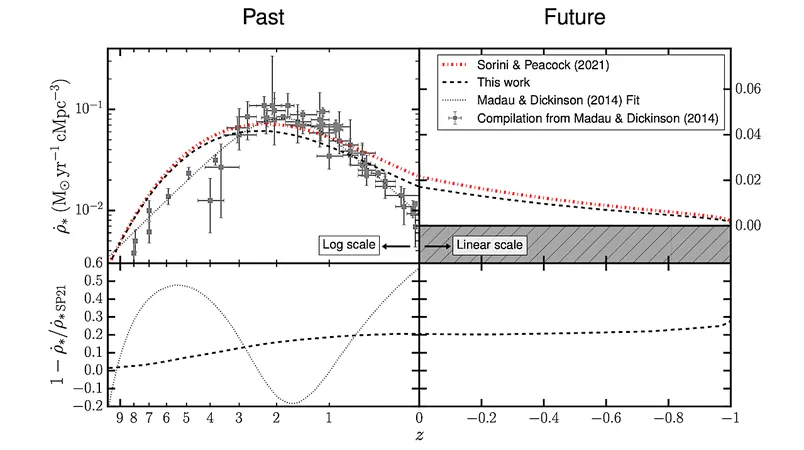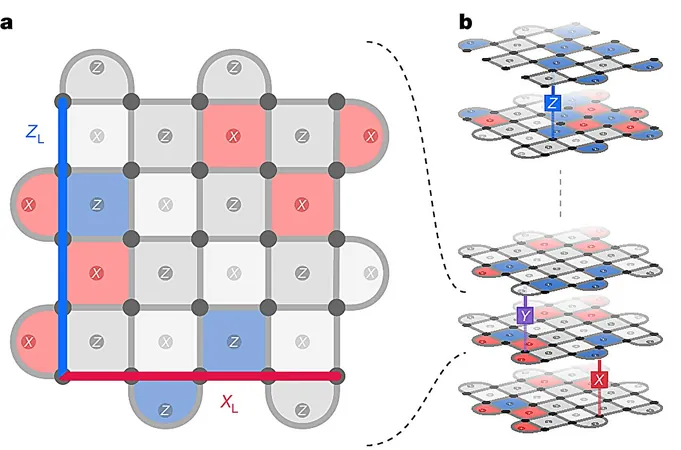
Unveiling the Secrets of the Cosmological Constant: How It Shapes Star Formation Across Time
2024-11-23
Author: Wei
Abstract
In a groundbreaking study, researchers have developed an extended analytical model to explore how the cosmological constant (Λ) impacts star formation history within the ΛCDM framework, which is the prevailing cosmological model describing the universe.
Key Findings
By analyzing a range of flat ΛCDM models, researchers varied the cosmological constant from Λ=0 to 105 times its observed value, Λobs. The results revealed a striking peak in the fraction of cosmic baryons converted into stars, reaching approximately 27% when Λ was within the range of 0.01 to 1 times Λobs. This signifies a pivotal threshold in the universe's star formation efficiency.
Impact of Cosmological Constant on Star Formation
The decline in efficiency at lower and higher values of Λ is attributed to two critical astrophysical factors. For lower values, the astrophysics of star formation plays a crucial role, while for higher Λ values, the suppression of cosmic structure formation becomes significant. Notably, the efficiency of star formation decreases gradually with increasing Λ, dropping below 5% only when Λ exceeds 100Λobs.
Observational Implications
This research also incorporated the assumption that the likelihood of generating observers—intelligent life capable of reflecting on their own existence—is proportional to star formation efficiency. As a part of this inquiry, following the principles established by noted physicist Steven Weinberg, researchers adopted a flat prior on Λ, leading to a median posterior value of approximately 539Λobs.
Anthropic Reasoning
Alarming as it is intriguing, the study highlights that the chance of observing Λ equal to or less than Λobs is merely 0.5%. This raises an eyebrow toward the notion that the observed cosmological constant might be unduly small when compared to expectations derived from the simplest multiverse theories.
Conclusion and Future Directions
The implications of this research are profound for debates surrounding anthropic reasoning—an approach often used to explain cosmic coincidences and the universe's apparent fine-tuning. The findings suggest two possibilities: either the anthropic argument may not hold water, or there are more parameters at play than just the cosmological constant.
Such revelations challenge our understanding of the universe and ignite endless questions about the origins of cosmic structures and the very nature of reality. As explorations in cosmology continue, one could ponder whether the universe, so finely tuned for life, is merely a coincidence or part of a grander multiverse tapestry—one that is yet to be deciphered.
This study is a pioneering contribution to our understanding of cosmology and may open doors to further inquiries into the complex relationship between cosmic parameters and the development of stars throughout the ages.




 Brasil (PT)
Brasil (PT)
 Canada (EN)
Canada (EN)
 Chile (ES)
Chile (ES)
 España (ES)
España (ES)
 France (FR)
France (FR)
 Hong Kong (EN)
Hong Kong (EN)
 Italia (IT)
Italia (IT)
 日本 (JA)
日本 (JA)
 Magyarország (HU)
Magyarország (HU)
 Norge (NO)
Norge (NO)
 Polska (PL)
Polska (PL)
 Schweiz (DE)
Schweiz (DE)
 Singapore (EN)
Singapore (EN)
 Sverige (SV)
Sverige (SV)
 Suomi (FI)
Suomi (FI)
 Türkiye (TR)
Türkiye (TR)